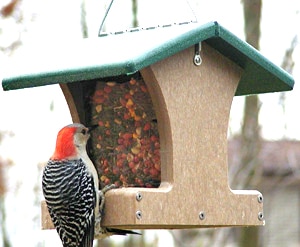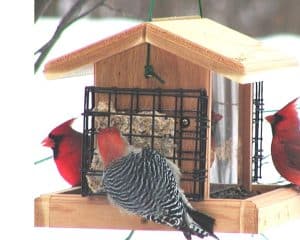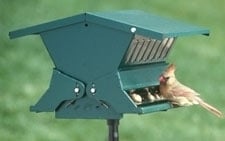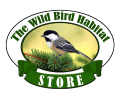Backyard Bird Feeding, Blog - General
Hopper Bird Feeders
 Hopper Bird Feeders –bird feeders that are filled generally from the top with wild bird feed with a reservoir that holds the feed. The amount of wild bird feed it holds depends on the size of the reservoir. The wild bird feeds then gravity flows out at the bottom into a trough or to ports at the bottom of the feeder. It may or may not have a perch. It may just be a ledge the bird stands on to feed. It might have a decorative shape or various other shapes in a vast array of colors. It may look like a barn, log cabin, or house. If it has a reservoir to hold wild bird feed that gravity flows the seed out the bottom, it’s a hopper bird feeder. It may be constructed of cedar, metal, plastic or poly-lumber from recycled plastics. Hopper bird feeders can be hung or post mounted depending on the design.
Hopper Bird Feeders –bird feeders that are filled generally from the top with wild bird feed with a reservoir that holds the feed. The amount of wild bird feed it holds depends on the size of the reservoir. The wild bird feeds then gravity flows out at the bottom into a trough or to ports at the bottom of the feeder. It may or may not have a perch. It may just be a ledge the bird stands on to feed. It might have a decorative shape or various other shapes in a vast array of colors. It may look like a barn, log cabin, or house. If it has a reservoir to hold wild bird feed that gravity flows the seed out the bottom, it’s a hopper bird feeder. It may be constructed of cedar, metal, plastic or poly-lumber from recycled plastics. Hopper bird feeders can be hung or post mounted depending on the design.
So, what kind of wild bird feed works best? One thing to keep in mind is the birds that come to elevated bird feeders are after one thing – the nut meats. This is why we don’t recommend a general white Proso millet based wild bird mix be used in any hanging or elevated wild bird feeder. The birds will pick and sweep through the general wild bird mix to get at those precious high energy nut meats, and you end up with wild bird seed scattered all over the ground. So, in a hopper style bird feeder you will want to use; black oil sunflower seeds, hulled sunflower seeds, safflower seed (either Nutra Saff safflower or the traditional white safflower) or a specialty nut mix blend with a combination of these seeds and will likely include shelled peanuts. Some specialty wild bird mixes even contain various tree nuts.
don’t recommend a general white Proso millet based wild bird mix be used in any hanging or elevated wild bird feeder. The birds will pick and sweep through the general wild bird mix to get at those precious high energy nut meats, and you end up with wild bird seed scattered all over the ground. So, in a hopper style bird feeder you will want to use; black oil sunflower seeds, hulled sunflower seeds, safflower seed (either Nutra Saff safflower or the traditional white safflower) or a specialty nut mix blend with a combination of these seeds and will likely include shelled peanuts. Some specialty wild bird mixes even contain various tree nuts.
What birds will be attracted to a hopper wild bird feeder? It varies. Hopper feeders are considered non-exclusive feeders meaning they don’t exclude any bird. Both large birds and small birds can easily access the wild bird feed in them. This may be why these feeders are so popular. Hopper bird feeders will attract a large number of bird species from Blue Jays to Chickadees, woodpeckers to finches. They easily attract the Northern Cardinal as cardinals which prefer to face forward as they forage in the feeder
I prefer to use hulled sunflower seed in a hopper bird feeder as it seems to attract the largest variety of both large and small birds. Hulled sunflower attracts American Goldfinches as well as Northern Flickers. Also hulled sunflower seeds are mess free,
If squirrels are a problem getting on the hopper bird feeder consuming all the wild bird feed and keeping the birds away, then consider a squirrel proof hopper bird feeder. Or you can properly locate your bird feeder where squirrel cannot jump to it and install a functional squirrel baffle. If that won’t work for you then use only safflower seed (either Nutra Saff safflower or traditional white safflower). Do not mix it with other products like sunflower seeds. 99% of squirrels will leave safflower seed alone but it will attract a large variety of birds.
So, if you were to have only one backyard bird feeder, a hopper bird feeder filled with the right wild bird feed would be my recommendation. You’ll attract a large variety of desirable birds. It works even better if you have two hopper bird feeders so you can offer a variety of wild bird feeds. Two will also help keep the feeders from getting overcrowded, or a dominant bird claiming a feeder keeping other birds at bay.
Now when you go to look at wild bird feeders, you’ll be aware of which ones are considered hopper bird feeders. Then it is just a matter of selecting one that is functional, durable, easy to clean, and of course, has pleasant aesthetics.
Wild Bird habitat Store’s HOPPER BIRD FEEDERS
Our BIRDS CHOICE & HILL TOP SPECIALTY HOPPER BIRD FEEDERS made from post consumer recycled plastics come with a Lifetime Warranty from fading, peeling, cracking, or chipping. They clean up like brand new even after years of use.
Like us on Face Book or follow us on Instagram for the next installment of the “Seven Basic Backyard Bird Feeders” to create a complete backyard bird feeding program that will attract the largest variety of desirable birds (and a few not so desirable) to your backyard.
